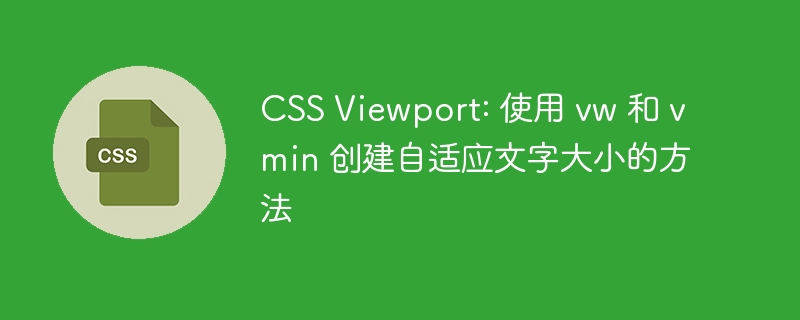Home >Web Front-end >CSS Tutorial >CSS Viewport: How to create adaptive text size using vw and vmin
CSS Viewport: How to create adaptive text size using vw and vmin
- 王林Original
- 2023-09-13 10:52:541259browse

CSS Viewport: How to create adaptive text size using vw and vmin
When developing responsive websites, we often encounter the need to adjust according to different device sizes Text size requirements. CSS Viewport units are a powerful tool for this purpose, and the vw and vmin units are particularly useful for creating adaptive text size effects.
Viewport refers to the area of the web page that users see in the browser. The vw unit represents a percentage of the viewport's width, while the vmin unit represents a percentage of the smaller of the viewport's width and height.
The following will introduce in detail how to use vw and vmin units to implement adaptive text size, including specific code examples.
First, we need to set the font-size attribute of the element that needs adaptive font size to a relative unit, such as vw or vmin. Here is a sample code:
h1 {
font-size: 6vw;
}
p {
font-size: 3vmin;
}In the above example, the font size of the h1 title will be automatically adjusted according to the width of the viewport, occupying 6% of the viewport width. The font size of the paragraph text will be based on the smaller of the viewport's width and height, occupying 3% of this value.
Next, we need to set the width and height of the viewport to ensure that the vw and vmin units can take effect correctly. Add the following meta tag to the head section of the HTML file:
<meta name="viewport" content="width=device-width, initial-scale=1.0">
The above code specifies the width of the viewport to be the device width and sets the initial scaling to 1.0.
Next, we can use vw and vmin units in CSS to create adaptive text size effects. The following is a complete sample code:
<meta name="viewport" content="width=device-width, initial-scale=1.0">自适应标题
自适应文本段落。
Through the above code, we can see that the title and paragraph text on the page will automatically adjust the font size according to the size of the device, thereby achieving an adaptive effect.
It should be noted that although the vw and vmin units are very convenient, in some cases it may cause the text to be too large or too small, so appropriate adjustments need to be made according to the actual situation. In addition, for some special cases, it may be necessary to use other techniques such as media queries to further optimize the adaptability of font size.
In summary, using the vw and vmin units of CSS Viewport can easily achieve the effect of adaptive text size. By setting the font-size attribute of an element, combined with appropriate viewport settings, we can easily create web pages that adapt to different device sizes.
The above is the detailed content of CSS Viewport: How to create adaptive text size using vw and vmin. For more information, please follow other related articles on the PHP Chinese website!

